Hanging Out in Paris
Cafés
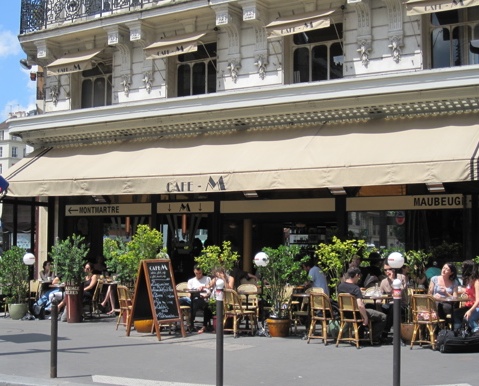 What an institution the café is. You can rent a table for as long as you want for the price of an espresso (3 or 4€), and no one will dare ask you to move on or hassle you about ordering more. Choose a café with an interesting view so you can sit back, relax, and take in everything that goes by. If you think a café is just a joint to grab a cup of coffee in, you've understood nothing about this wonderful institution. You'll see people engaged in all sorts of activities at a café: reading, looking at their phone or their computer, staring blankly, watching the passers-by, and talking with friends. Cafés have their own character and their own cultures, and if you go to the same one for several days running, the waiters will acknowledge you. Just about any café that looks interesting will be fine. Stay away, however, from the ones you've heard of (Deux Magots, Café de la Paix, etc.) because they'll be astronomically expensive, and, paradoxically (or not), not as interesting.
What an institution the café is. You can rent a table for as long as you want for the price of an espresso (3 or 4€), and no one will dare ask you to move on or hassle you about ordering more. Choose a café with an interesting view so you can sit back, relax, and take in everything that goes by. If you think a café is just a joint to grab a cup of coffee in, you've understood nothing about this wonderful institution. You'll see people engaged in all sorts of activities at a café: reading, looking at their phone or their computer, staring blankly, watching the passers-by, and talking with friends. Cafés have their own character and their own cultures, and if you go to the same one for several days running, the waiters will acknowledge you. Just about any café that looks interesting will be fine. Stay away, however, from the ones you've heard of (Deux Magots, Café de la Paix, etc.) because they'll be astronomically expensive, and, paradoxically (or not), not as interesting.

What do you order at a café? Well, what do you want? In the morning, you can get anything from an espresso (un café) or café crème (café au lait—coffee with a fair amount of milk in it) and a croissant or pain au chocolat to a full-blown American-style breakfast (although the latter, not at all common outside from the giant cafés near tourist districts, really only exists for tourists). Lunch time? Most cafés serve food, and lunches in Paris tend to be a bit bigger than in the U.S. Sandwiches and salads or heavier fare—the sorts of meals you might expect to see at dinner—aren't at all uncommon at lunch here. Try a croque monsieur (see below), a sort of grilled ham and cheese sandwich. Evening? Have an apéritif (before-dinner drink) or a glass of wine, a beer, a pastis (anise-flavored, fairly strong drink), or anything else that strikes your fancy. The café is as versatile as your tastes, and there really isn't any limit to the kind of café you might find yourself in. Some are snooty and oh so refined, while others are working class and, interestingly, just as refined.
You can rent a table for as long as you want for the price of an espresso and no one will dare ask you to move on.
Prices range enormously at cafés. A good rule of thumb for knowing if you're paying too much: if a coffee (un café) costs more than about 3–4€, then you're at an expensive place. A beer (25 centilitres, or about half a pint) should run you between 4 and 6 euros. Prices go up slightly at night. So, if you're at an expensive place, go someplace else for the second round. Note that non-alcoholic drinks are at least as expensive as alcohol, which shows you where the French head is at. Liquor can be somewhat expensive. A gin and tonic will set you back 7 euros or more. To order a draft beer, say "un demi," (unh demee) which means a half pint of draft. The waiter might ask you what kind and if he does, ask him for a carte, which will likely be on the table anyway. (I'm partial to the Belgian beer Leffe.) If you don't know what to get and you don't want beer, you can get a glass (un verre) of white or red wine (de blanc, de rouge). That is, order "un verre de blanc" or "un verre de rouge" and the waiter will know that you want the house wine. He might ask you what kind, but just go with it.

If you want coffee in the morning at a café, there are two things to know. If you order "un café" you'll get a small cup of espresso. This is what most people drink. If you order "un café crème" (unh cafay crem) you'll get what Americans consider a regular size cup of coffee with steamed milk in it. You'll also pay more for it. If you do want this, be cool and order "un crème" or "un grand crème." You're best off, by the way, not ordering un café crème after dinner, because it will cost as much as your food. (If you ever order a glass of milk, for watever reason, people will just think you are insane.) If you want what would be a cup of coffee in the US, order "un café allongé." Or, just order un café, and if you don't like small cups of espresso, then tough. You can generally get croissants, etc., in cafés for breakfast, too, at reasonable prices.
If you're going to meet someone before going out, and you haven't decided where to go first, tradition has it that you meet at the Fontaine St Michel, right at the 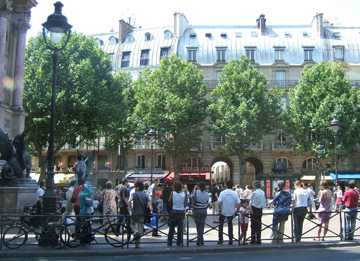 very base of the Boulevard St Michel. It's located on a big and bustling square, and there will likely be lots and lots of young people hanging out here (some of them might even be causing some form of mild mischief, such as coloring the water in the fountain). Don't worry, though, if you're not exactly a youth—you'll see people of all ages waiting for their rendezvous here, and it's lively and pleasant here throughout the year. There might also be some activities, displays, or what-not, depending on what time of the year you're here.
very base of the Boulevard St Michel. It's located on a big and bustling square, and there will likely be lots and lots of young people hanging out here (some of them might even be causing some form of mild mischief, such as coloring the water in the fountain). Don't worry, though, if you're not exactly a youth—you'll see people of all ages waiting for their rendezvous here, and it's lively and pleasant here throughout the year. There might also be some activities, displays, or what-not, depending on what time of the year you're here.
Particularly good cafés
La Rhumerie. 166 boulevard St. Germain, near the metro stop Mabillon. This place has been around for something like 90 years. Order a "punch blanc" and you'll get a full glass of rum with ice cubes floating precariously around in it and something else of 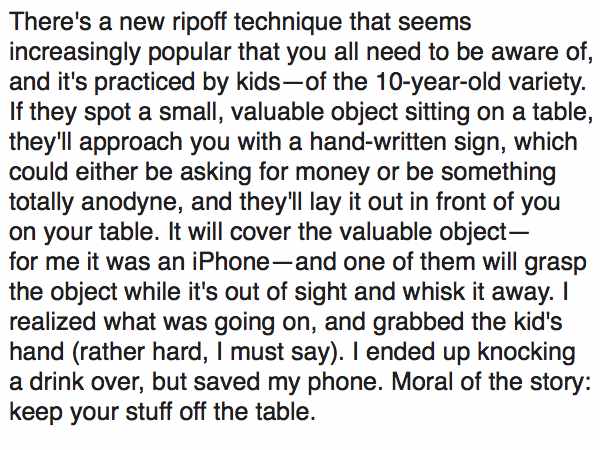 indeterminate nature (update: Chris reports that it's simple syrup in the punch blanc). It's surprisingly good and will get you very drunk very fast. This can be a very strange and interesting café; the people seem somehow sordid and extremely ordinary at the same time, and the place, predictably, gets more interesting as the night moves on. You absolutely must get a table by the window, especially if it's summertime (you'll see why, and you'll also see why you can almost come to blows fighting for one of the two truly superb tables). Try to look bored and sophisticated here. Also try Le Mabillon, right next door at 164. It's somewhat more stylish and, thus, less sophisticated. Also try Le Mondrian, at number 148 blvd Saint Germain, which is neither of those things, and yet—or hence—very nice.
indeterminate nature (update: Chris reports that it's simple syrup in the punch blanc). It's surprisingly good and will get you very drunk very fast. This can be a very strange and interesting café; the people seem somehow sordid and extremely ordinary at the same time, and the place, predictably, gets more interesting as the night moves on. You absolutely must get a table by the window, especially if it's summertime (you'll see why, and you'll also see why you can almost come to blows fighting for one of the two truly superb tables). Try to look bored and sophisticated here. Also try Le Mabillon, right next door at 164. It's somewhat more stylish and, thus, less sophisticated. Also try Le Mondrian, at number 148 blvd Saint Germain, which is neither of those things, and yet—or hence—very nice.  In the same general vicinity is Le Procope, right around the corner at 13 rue de l'Ancienne Comédie, which you really ought to go to, if only for historical purposes. Widely billed as the first café in France (it was founded in the late seventeenth century, and one of the early adopters of the new substances of coffee and chocolate), it was frequented by all the major French luminaries, including Rousseau, Diderot, Voltaire, and Hugo. Tom doesn't especially recommend the food there, but do check it out and at least have un café. The surroundings are beautiful and there's some good people-watching.
In the same general vicinity is Le Procope, right around the corner at 13 rue de l'Ancienne Comédie, which you really ought to go to, if only for historical purposes. Widely billed as the first café in France (it was founded in the late seventeenth century, and one of the early adopters of the new substances of coffee and chocolate), it was frequented by all the major French luminaries, including Rousseau, Diderot, Voltaire, and Hugo. Tom doesn't especially recommend the food there, but do check it out and at least have un café. The surroundings are beautiful and there's some good people-watching.
Knowing you the way I do, I'm pretty sure that if you're in this neighborhood and you're into it, you'll also like the establishments in the rue des Canettes area. After you have your apéritif in one of the Saint Germain cafés listed above (or wherever), head to the metro stop Mabillon. Then head down the rue du Four, turn left on the rue Princesse, and now you're in the area I'm talking about. Check out the bars and restaurants on this street, go to the end, turn right, and head on over to the rue des Canettes. You'll find somet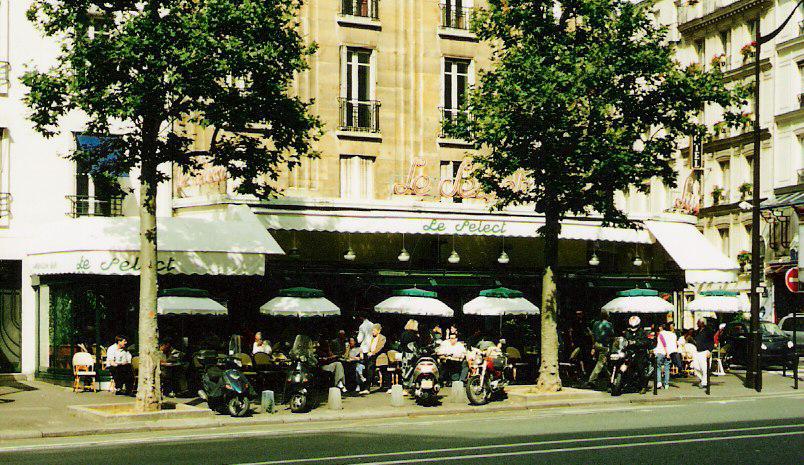 hing you like—I promise.
hing you like—I promise.
Le Select, at 99 Boulevard du Montparnasse near the skyscraper is famous, but not as expensive as the other well-known places. Jean-Paul Sartre and Simone de Beauvoir used to hang out here and at the Coupole across the street and talk about existentialism and smoke too much, wondering why Jean-Paul's ears were so large. Very hip but doesn't show it. Go there and try to look like you're a regular. Talk about the society of spectacle or something. I saw a waiter actually punch out a female customer here once, bringing the entire crowd to its feet. You may see very old, once famous philosophers hanging out here, so try to look smart.
Au trappiste. 4, rue St. Denis, right by the Place du Châtelet. Not run by trappist monks, but that's where it gets its name. Zillions of beers from around the world, but primarily Belgian. They have mussels and French fries to die for here. Try to sit downstairs, but it's OK if you have to go upstairs, in which case you should try to get a seat by the window. This is a crowded and really fun place. Lots of youngish people and a very active, intelligent crowd. Great place for lunch, btw.
In the same general vicinity, at 1 Place du Chatelet, is Le Zimmer. This is an old stand-by among a certain kind of upscale crowd and some tourists. Mostly quiet and tranquil, it's got a great view of the Place, which hosts a very beautiful fountain. There are often odd little goings-on on this Place, and if you're sitting at the Zimmer you have a good view of all of them. Go inside and look at the astonishingly beautiful zinc ceiling. They also have excellent lunches here. While I was sitting on the terrasse one day a rollerblader fell into my lap here.
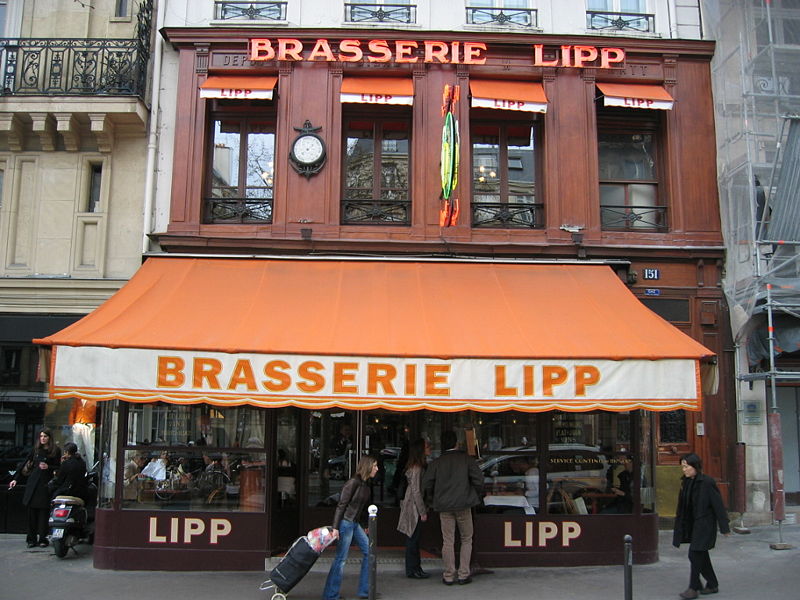 Some of the more famous and storied institutions include the Café de la paix, 2, rue Scribe, near the Opéra (and at that metro), or the Deux Magots, at 6, place St Germain (note that these are not near one another). Both of these neighborhoods are exceptional for people-watching. The Café de la Paix is two steps from the Opéra Garnier, along with some terrific shopping. It's also on the famous Grands Boulevards, which I tell you more about elsewhere in Tom's Guide. The Deux Magots is on the fashionable Boulevard Saint-Germain, near many of the top art galleries, good restaurants, and also good shopping. Try to get into Lipp (151 boulevard Saint Germain, metro Saint-Germain des Prés), which is much, much cooler, and also much more of a challenge: if you're going to eat, try to get seated on the ground floor (you won't be able to, because you're just a nobody, but try anyway. They'll end up seating you on the upper level [Siberia]; if they tell you you would have a 45-minute wait to sit on the ground level, don't believe it, and you'll just look like a fool waiting, because they'll never seat you on the ground floor.).
Some of the more famous and storied institutions include the Café de la paix, 2, rue Scribe, near the Opéra (and at that metro), or the Deux Magots, at 6, place St Germain (note that these are not near one another). Both of these neighborhoods are exceptional for people-watching. The Café de la Paix is two steps from the Opéra Garnier, along with some terrific shopping. It's also on the famous Grands Boulevards, which I tell you more about elsewhere in Tom's Guide. The Deux Magots is on the fashionable Boulevard Saint-Germain, near many of the top art galleries, good restaurants, and also good shopping. Try to get into Lipp (151 boulevard Saint Germain, metro Saint-Germain des Prés), which is much, much cooler, and also much more of a challenge: if you're going to eat, try to get seated on the ground floor (you won't be able to, because you're just a nobody, but try anyway. They'll end up seating you on the upper level [Siberia]; if they tell you you would have a 45-minute wait to sit on the ground level, don't believe it, and you'll just look like a fool waiting, because they'll never seat you on the ground floor.).
OK, I thought a long time before I put this in, but I decided since you're probably going to end up on the Boulevard Saint-Michel anyway, you might as well know which café to go to. It's Le Départ, at the very beginning of the boulevard, right by the river (1, place St Michel). It's big and sprawling, and there's almost nothing to recommend it. In fact, the service here is actually appalling: you will have to beg a waiter to deign to even look at you, and your order will take so long to come you won't even want it anymore. I've tried this place on a number of occasions and it's still the same—a friend and I waited 15 minutes for a waiter, and then almost another 15 minutes for our drinks. The only thing to recommnd it is that there's a very good scene passing by in front of you. This used to be a good place to nurse a drink (once you actually get it), but now the ticket/check says that they will renew your drink every 30 minutes (presumably to discourage you from lounging about). Judge for yourself. Would love to change my mind about this place: any other experiences out there?
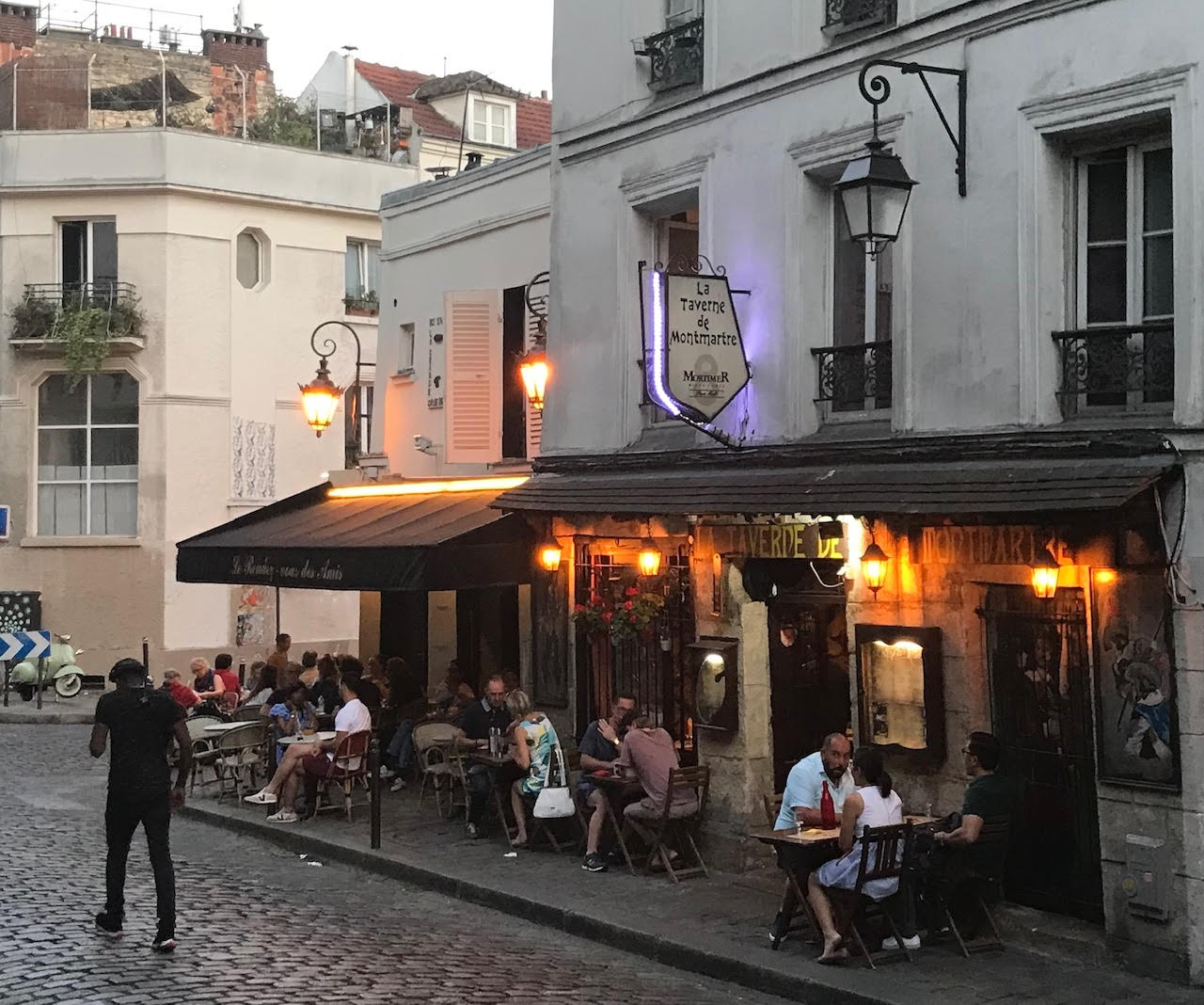 On the other hand, if you want to sit someplace and look at Notre Dame and actually be waited on by friendly and attentive waiteers, the place to go is Café Panis at 21 Quai Montebello. There will be a lot of activity here, but the food is good, the view is nice, and prices aren't at all bad for the neighborhood. They used to have the best "sandwich mixte" (basically ham and cheese on buttered baguette) in the city; they no longer serve those, but you should go here anyway. Actually, ask for the sandwich mixte: maybe they'll start serving it again. There are sometimes pigeons that wander in here. Café Panis is right across the river from the cathedral, on the 5th-arrondissement side of things, right by the famous Shakespeare and Company bookstore (at 37 rue Bûcherie). By the way, there's an odd new phenomenon at Shakespeare and Company where people now wait in a long line just to get in—that in itself tells us that what this bookstore used to be is long gone, so don't bother to wait. The place isn't what it used to be.
On the other hand, if you want to sit someplace and look at Notre Dame and actually be waited on by friendly and attentive waiteers, the place to go is Café Panis at 21 Quai Montebello. There will be a lot of activity here, but the food is good, the view is nice, and prices aren't at all bad for the neighborhood. They used to have the best "sandwich mixte" (basically ham and cheese on buttered baguette) in the city; they no longer serve those, but you should go here anyway. Actually, ask for the sandwich mixte: maybe they'll start serving it again. There are sometimes pigeons that wander in here. Café Panis is right across the river from the cathedral, on the 5th-arrondissement side of things, right by the famous Shakespeare and Company bookstore (at 37 rue Bûcherie). By the way, there's an odd new phenomenon at Shakespeare and Company where people now wait in a long line just to get in—that in itself tells us that what this bookstore used to be is long gone, so don't bother to wait. The place isn't what it used to be.
While you're in the fifth, walk down to the eastern end of the boulevard St-Germain. You'll notice it gets quieter the farther you go from St Michel, and you'll find some interesting little restaurants and cafés, especially if you explore the side streets. Tom's favorite is Le Métro Café, at 18 Place  Maubert (really it's on the boulevard St-Germain, just by one of the entrances to metro Maubet-Mutualité). Tom does recommend the simple food here, and get a cognac for him when you go. Just across the street is the excellent Village Ronsard, where the service is only slightly better, but the pours are somewhat healthier; the food is just as good, and they're open until 2:00 in the morning (but I think the kitchen closes around 10:30 or so).
Maubert (really it's on the boulevard St-Germain, just by one of the entrances to metro Maubet-Mutualité). Tom does recommend the simple food here, and get a cognac for him when you go. Just across the street is the excellent Village Ronsard, where the service is only slightly better, but the pours are somewhat healthier; the food is just as good, and they're open until 2:00 in the morning (but I think the kitchen closes around 10:30 or so).
La Palette, at 43 rue de Seine, has gone down and back up in Tom's estimation. In the past, it was way cool and there were all kinds of other things to recommend it, especially the server that we all knew and loved (you knew you had made it when he would use the familiar "tu" personal pronoun, and when he would occasionally add up your check incorrectly in a way that was favorable to you and then wink).
 We even liked the Turkish toilet that would overflow fresh water onto your feet when you flushed it—those in the know would flush and jump. For a while, however, the service seemed to be bordering on the rude, and the charm that the establishment used to exude seemed no longer present. Tom is especially pleased to report that La Palette is back to its former glory, and may even have surpassed it. It's a hot ticket on a warm summer night—hard to get a table—and the waiters, who can't match Jean-François' charm, are nevertheless wry and attentive. Lots of beautiful people here and, rumor has it, some big-wig politico types. Go here. And if you have to go to the bathroom, well, they've fixed the toilet and there's no more jumping required (alas).
We even liked the Turkish toilet that would overflow fresh water onto your feet when you flushed it—those in the know would flush and jump. For a while, however, the service seemed to be bordering on the rude, and the charm that the establishment used to exude seemed no longer present. Tom is especially pleased to report that La Palette is back to its former glory, and may even have surpassed it. It's a hot ticket on a warm summer night—hard to get a table—and the waiters, who can't match Jean-François' charm, are nevertheless wry and attentive. Lots of beautiful people here and, rumor has it, some big-wig politico types. Go here. And if you have to go to the bathroom, well, they've fixed the toilet and there's no more jumping required (alas).
Bars
In general, although this is by no means a hard and fast rule, bars in Paris—as opposed to cafés, which you'd have figured out just by having your eyes open—tend to be small, dark, and crowded. I take this to be a good thing, but if you're claustrophobic or like to be seen you might not find this as appealing. A few good bars you might want to check out:
Oddly enough, the Pub St. Michel, at 19, Quai St. Michel (metro Saint Michel), turns out to be a pretty good place. You'd think it'd be some kind of weird tourist trap, but it's not. It's huge (it has several floors) and on the ground floor they do serious—and I mean serious—karaoke. It's mostly popular French and some American songs, and some of these people can really belt it out. I was shocked to go there once with my friend Maroussia, whom I had known for going on fifteen years, and discovered that she could have a career as a chanteuse. In fact, she brought the house down with her rendition of "Mademoiselle Chante le blues." If you don't like karaoke, just go upstairs. This place is open until 5:00 am.
Polly Maggoo. 11, rue Saint Jacques, very close to Notre Dame. Oh, lord. In its original manifestation, this place was amazing. It was open all night, and it was a good thing, too, because the people who went here after about 2:00 A.M. shouldn't have been allowed on the streets. Before 2:00 you got a strange mix of would-be fashion models and even some yuppie types; after that you got the people who were kicked out of the other bars. The other good thing was that it was cheap. It wasn't too dangerous, and you always knew that you probably wouldn't get beaten up. It was worth going to at about 3:00 in the morning because something strange was bound to be going on. I once saw someone climb up the front of the building and into a hotel window and then the night manager came out with a huge club. We then left. Apparently Jim Morrison used to hang out here, but I never saw him. UPDATE: Tragically, Polly Magoo has closed! Sometime during the month of June, this Paris institution closed its doors forever (actually, the entire building in which it's located is falling down and it looks like the folks inside barely made it out alive.) UPDATE AGAIN: Polly Magoo has re-opened! But it's not quite the same thing. It's basically right next door to where it used to be, but now it's sort of, well, nice. Go anyway and pretend it's as cool and sleazy and great as it used to be. It's not, but some of the old joint's lore might rub off on you.
For a good place right nearby—actually, just right next door—go to the Pub Shywawa. It's not as bizarre or interesting as the old Polly Magoo, but it's a genuinely excellent bar. In the summertime 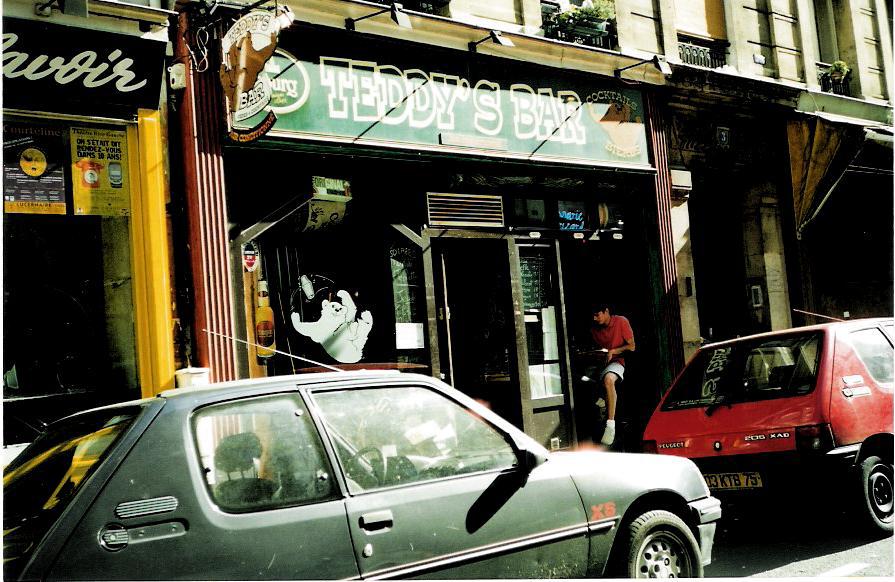 they have tables just inside the doors so you can get some fresh air, or you can disappear inside into its darker recesses. Don't be a jerk and order one of the bizarre beer and liquor cocktails.
they have tables just inside the doors so you can get some fresh air, or you can disappear inside into its darker recesses. Don't be a jerk and order one of the bizarre beer and liquor cocktails.
The Place Contrescarpe, which is at the very top of the rue Mouffetard in the Latin Quarter has been becoming increasingly popular with the 20-something set and older. There are two large cafés that bound either side of the Place. These are the Café Delmas and The Contrescarpe. In part because there is always a great deal of activity on the Place itself, these places are typically jammed (especially in good weather), and they're both excellent places to hang. The smaller bars on the nearby streets—the rue Descartes, the rue Mouffetard, the rue du Cardinal Lemoine, the Place Emmanuel-Levinas, the rue Thouin—have a lot to offer. Tom suggests Teddy's Bar,at 3, rue Thouin, which you might not be surprised to learn has a lot of Teddy Bears hanging around; at 10, rue Mouffetard the Requin Chagrin, which Tom has always been partial to, and not just because of the great name (it means something like "sad shark" and there is a genuine species of shark popularly called this)—they also have a great beer selection. You might also like the more upscale Barong Bar, at number 5, rue Blainville/Emmanuel-Levinas, especially if you're more inclined toward cocktails. The Café des Arts, at 3, Place de la Contrescarpe, is a bit more raucous and beer-centered, and also a little sportier. Just down the slope of the Rue Mouffetard you'll find IPN (and I don't know what that stands for), which is actually more of a nightclub (with dancing, too). Don't miss the famous Bateau Ivre (at number 40, rue Descartes) if you want to catch a game or maybe a standup comic. (Tom feels the need to point out that
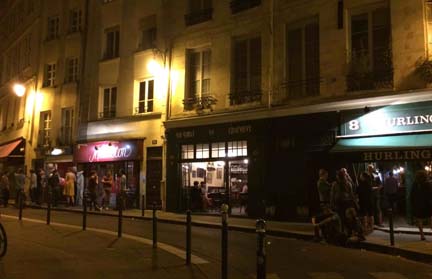 "Le Bateau Ivre" is the title of a poem written by 16-year-old Arthur Rimbaud, in which he describes a drunken boat careening around at sea.) While we're on things literary in this neighborhood, go around the corner to the top of the rue du Cardinal Lemoine, and at number 74 you'll see the plaque designating Ernest Hemingway's apartment.
"Le Bateau Ivre" is the title of a poem written by 16-year-old Arthur Rimbaud, in which he describes a drunken boat careening around at sea.) While we're on things literary in this neighborhood, go around the corner to the top of the rue du Cardinal Lemoine, and at number 74 you'll see the plaque designating Ernest Hemingway's apartment.
If you're in the neighborhood, and if you're between the ages of, say 20 and 26, go to the bottom of the rue Descartes where it connects with the rue de la Montagne Ste Geneviève, which is a nice five-minute walk down from the rue Mouffetard. There you'll find several strange and interesting places, mostly clustered around the non-descript Placette Jacqueline-de-Romilly. Be sure to check out in particular (at no. 8, rue Descartes) the oddly and perhaps appropriately named Hurling Pub, an Irish bar with your favorite Irish beers and lots of sports (and a good place to watch a match); and L'Annexe and La Méthode, at numbers 4 and 2 respectively. For a truly excellent English pub, go 200 feet or so around the corner up to your left on the Rue de la Montagne Ste. Geneviève to number 2, Place du Panthéon. There you'll find Le Bombardier, one of Tom's favorite places to grab a great beer.
If you keep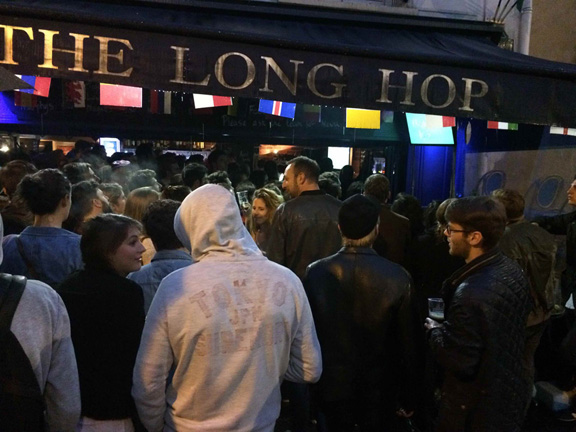 on heading down the rue Descartes it will turn into the rue de la Montagne Sainte-Geneviève, and you should be sure to check out the establishments in this area, in particular the Violin Dingue ("crazy violin"), at number 46, which is a close approximation of a US college bar. Also in the 5th is the Long Hop, a good sports bar at number 25 rue Frédéric Sauton, just off the boulevard Saint Germain. Pre-pandemic Long Hop was a lively and interesting place with a pool table, something you don't often see. It seems to be gentrifying somewhat—people don't yell and scream here anywhere near as much as they used to (but the pool table's still there). For screaming, though, go here when there's a good soccer match on. The photo here was taken during the 2016 UEFA championship quarter finals. Yes, it's raining, but no one noticed (France beat Iceland). Go all the way down the hill (the rue du Cardinal Lemoine) to the blvd Saint-Germain and you'll find Le Nouvel Institut (1, blvd Saint-Germain, métro Cardinal Lemoine or Jussieu, 01 42 39 94 99). During the day it's a quite good brasserie with inventive salads, sandwiches, burgers, pizzas, and traditional fare. Perhaps because of its location—directly across from the Institut du Monde Arabe and the Jussieu (sciences) campus of the Université de Paris—in the evenings this place turns into a kind of campus bar with mostly twenty-somethings drinking, munching, and hanging out. This area was a hotbed of activity during the student upheavals in 1968.
on heading down the rue Descartes it will turn into the rue de la Montagne Sainte-Geneviève, and you should be sure to check out the establishments in this area, in particular the Violin Dingue ("crazy violin"), at number 46, which is a close approximation of a US college bar. Also in the 5th is the Long Hop, a good sports bar at number 25 rue Frédéric Sauton, just off the boulevard Saint Germain. Pre-pandemic Long Hop was a lively and interesting place with a pool table, something you don't often see. It seems to be gentrifying somewhat—people don't yell and scream here anywhere near as much as they used to (but the pool table's still there). For screaming, though, go here when there's a good soccer match on. The photo here was taken during the 2016 UEFA championship quarter finals. Yes, it's raining, but no one noticed (France beat Iceland). Go all the way down the hill (the rue du Cardinal Lemoine) to the blvd Saint-Germain and you'll find Le Nouvel Institut (1, blvd Saint-Germain, métro Cardinal Lemoine or Jussieu, 01 42 39 94 99). During the day it's a quite good brasserie with inventive salads, sandwiches, burgers, pizzas, and traditional fare. Perhaps because of its location—directly across from the Institut du Monde Arabe and the Jussieu (sciences) campus of the Université de Paris—in the evenings this place turns into a kind of campus bar with mostly twenty-somethings drinking, munching, and hanging out. This area was a hotbed of activity during the student upheavals in 1968.
If you're in the Saint Paul neighborhood (sort of like an entrance to the marais), head on over to Le Bûcheron at 14 rue Rivoli, or Les Chimères at 133 rue Saint-Antoine. Both these places are right smack in the Saint Paul district, just outside the marais, so there's plenty to recommend them, at least as far as the neighborhood goes, and both are open until 2:00 am. Les Chimères has a weird history. It used to be a, umm, what? club/bar type thing; now it's a decent bar/café with excellent people-watching and Tom recommends it highly. Le Bucheron is friendly, if a little odd (but in a good way). If you go here make sure to play with the weird menu thing that slides out of the tables just inside the door (you'll see what I mean). A short walk away is the Pure Malt at 4 rue Caron (01 42 76 03 77). A nice little Scottish bar with a terrific menu of beers and whiskeys, this place is typically hopping on the weekends, and much calmer—and nicer—during the week. Just off the beautiful Place du Marché Sainte Catherine, which you should check out for extremely 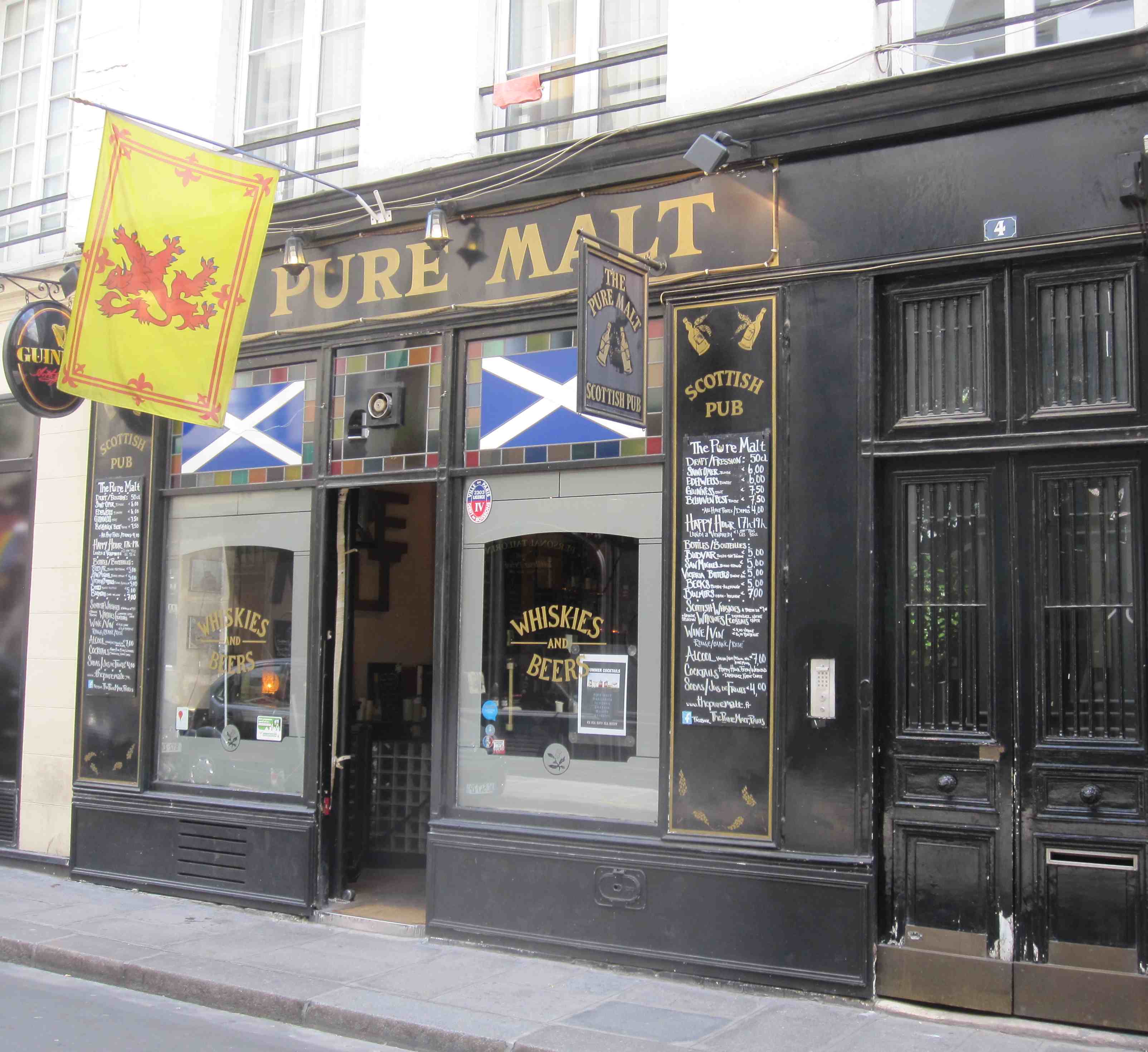 pleasant outdoor dinners during the warm months, the Pure Malt boasts a warm interior and interesting people. The bartender can be somewhat crabby. [But, since I first wrote this, he wrote to me and said he didn't know he was being crabby, and I have to say, he seemed like a nice bloke—so go here.]
pleasant outdoor dinners during the warm months, the Pure Malt boasts a warm interior and interesting people. The bartender can be somewhat crabby. [But, since I first wrote this, he wrote to me and said he didn't know he was being crabby, and I have to say, he seemed like a nice bloke—so go here.]
Two areas that are really hopping, particularly on weekends, are the marais and Bastille.
Two areas that are really hopping, particularly on weekends, are the marais and Bastille, and they attract somewhat different crowds (and for what it's worth, not as many tourists as the Latin Quarter). The marais is loaded with a mix of bars ranging from the somewhat sophisticated to the downright trashy (in a good way); it attracts a largely gay clientele; a small number of the places don't admit women, but you're not likely to just fall into them, and if you do, they'll tell you. Don't worry about it.) Most of the gay bars are on the rue des Archives and the rue Vieille du Temple, with the rue Ste. Croix de la Bretonnerie making the connection. L'Open Café on the rue des Archives has the reputation of being one of the friendliest places; Le Feeling Bar has the opposite reputation (or, as one friend put it, "It ought to be called the 'Bad' Feeling Bar"). Le Central was sort of the grandfather of them all—it had apparently been around the longest, but it's closed now. The most famous lesbian club in the neighborhood was Bliss Kfé, at 30 rue Roi de Sicile (on the corner of the rue des Ecouffes), but it, too, closed for good recently. For other places, gay, straight, or mixed, head up the rue vieille du temple off of the rue de Rivoli. Pass an odd placed named Pick Clops, which has a good bar you can sit at (rumor has it it's named after folks who cadge cigarettes, which makes sense, I guess) and then you'll come across an 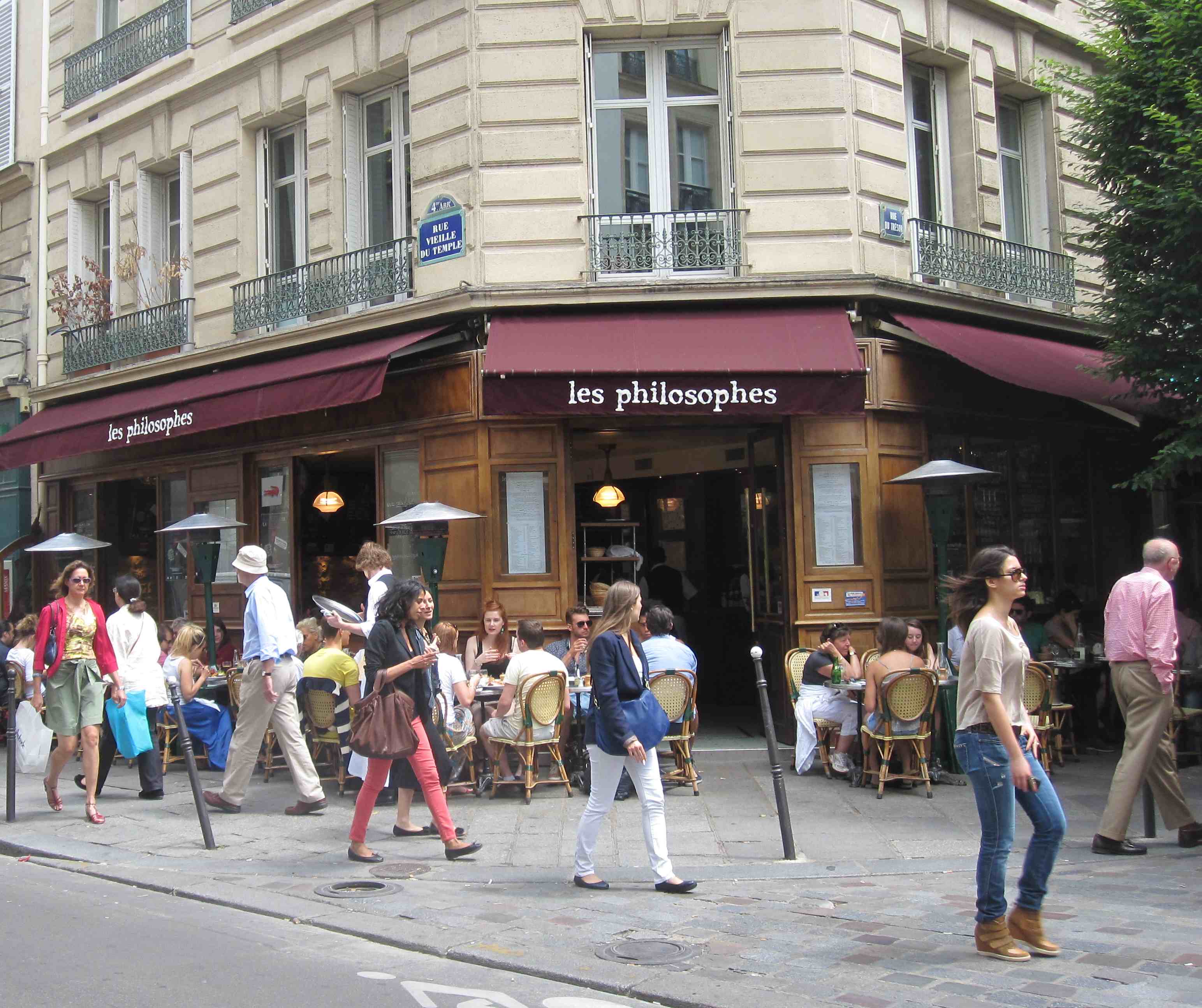 excellent hangout called Les Philosophes (28, rue vieille du temple). Just try and get a table outside. Keep on going up the rue vieille du temple, and you'll find a few more interesting cafés/bars within a few streets; the Petit Fer à cheval is especially good. Try also Yono at 37 rue Vieille du Temple (just head under the strange, dark arch). It's a cool, multi-level place with lots of beautiful and regular people. The Lizard Lounge is also very popular (18 rue du Bourg Tibourg), but gets really, really crowded, and a lot of people like the similar Stollys at 16 rue du Cloche Percé, or the Klein Holland at 36 rue Roi de Sicile. I'm very fond of the Klein Holland, because it's a quiet bar on weekdays where you can go and just hang out, but then on weekends it has just enough activity to be festive, but not so much that it annoys you. Wait—maybe I shouldn't tell anyone that. Explore the side streets around here—in particular the rue des Blancs Manteaux, rue de la Verrerie, and the rue Ste. Croix de la Bretonne. You'll find some terrific places; in some of them people are dressed in a kind of sophisticated casual chic; in others jeans and Ts.
excellent hangout called Les Philosophes (28, rue vieille du temple). Just try and get a table outside. Keep on going up the rue vieille du temple, and you'll find a few more interesting cafés/bars within a few streets; the Petit Fer à cheval is especially good. Try also Yono at 37 rue Vieille du Temple (just head under the strange, dark arch). It's a cool, multi-level place with lots of beautiful and regular people. The Lizard Lounge is also very popular (18 rue du Bourg Tibourg), but gets really, really crowded, and a lot of people like the similar Stollys at 16 rue du Cloche Percé, or the Klein Holland at 36 rue Roi de Sicile. I'm very fond of the Klein Holland, because it's a quiet bar on weekdays where you can go and just hang out, but then on weekends it has just enough activity to be festive, but not so much that it annoys you. Wait—maybe I shouldn't tell anyone that. Explore the side streets around here—in particular the rue des Blancs Manteaux, rue de la Verrerie, and the rue Ste. Croix de la Bretonne. You'll find some terrific places; in some of them people are dressed in a kind of sophisticated casual chic; in others jeans and Ts.

For a complete change of pace, head over to the Bastille. You'll find that the Place de la Bastille itself is pretty hopping, and the more you head north and east on the place the younger and somewhat rowdier it gets. Directly on the place is Tom's favorite, the Café des Phares, which is right where the rue Saint-Antoine empties out into the Place de la Bastille. This place calls itself a "café philo," because they have discussions of that nature here. Also very good is the Café Français (with an uninspiring web presence), at 1-3 Place de la Bastille. This place is somewhat more expensive than the other establishments around the Place de la Bastille, but it's also quite a bit nicer, and the food is a little more refined as well. It's also a bit calmer, with a good variety of indoor and outdoor seating, so if that's what you're looking for, head this way.
Go to the northeast quadrant of the Place de la Bastille and head down the rue de la Roquette.If you keep going clockwise around the edge of the Place you'll come to a couple places that are neither here nor there. Next in line around the ring is the Falstaff Cafe, at 10-12, Place de la Bastille, which is perfectly acceptable. If none of those moves you, have a drink at one of the bars or cafés right on the main square. And if those don't do it for you—if you want more nightlife action—go to the northeast quadrant of the Place de la Bastille (if the Bastille is a clock, this would be at around 1:00 or 2:00, with the Opera at about 4:00) and head down the rue de la Roquette. You'll see a whole lot of places to hang after the first block or so,
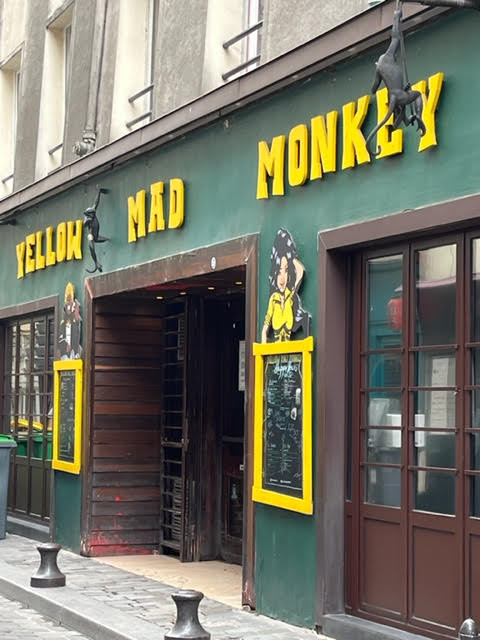 and when you get to the rue de Lappe, which is just a few blocks from the Bastille, hang a right and check out the scene there. This somewhat narrow, mostly pedestrian street has a dozen or more bars and clubs of all different characters, but what they have in common at night and on the weekends are crowds of young folks, mostly of the under 30 variety. A lot of these places change hands pretty frequently (especially since the panemic), and I don’t have the time to keep updating this, but check out the Balajo, which claims to have been around since the 1930s; the Chapelle des Lombards; and/or the Berliner Wunderbar at the far end of the street. You also might enjoy Yellow Mad Monkey. There's also at least one decent restaurant on this street (but determining which one is left as an exercise for the reader).
and when you get to the rue de Lappe, which is just a few blocks from the Bastille, hang a right and check out the scene there. This somewhat narrow, mostly pedestrian street has a dozen or more bars and clubs of all different characters, but what they have in common at night and on the weekends are crowds of young folks, mostly of the under 30 variety. A lot of these places change hands pretty frequently (especially since the panemic), and I don’t have the time to keep updating this, but check out the Balajo, which claims to have been around since the 1930s; the Chapelle des Lombards; and/or the Berliner Wunderbar at the far end of the street. You also might enjoy Yellow Mad Monkey. There's also at least one decent restaurant on this street (but determining which one is left as an exercise for the reader).
Now if you're just a bit older than the folks who dig the scene on the rue de Lappe, you have two alternatives. Instead of turning right on the rue de Lappe, keep heading straight on the rue de la Roquette, and when you get the the rue Keller (which will be the 4th street on your right (depending on how you count), head down this street of many transformations. This street has been somewhat gentrified, and now most of the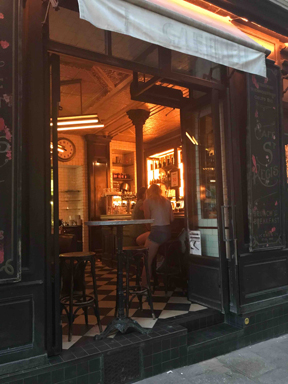 establishments are upscaled and/or hipsterized. There's still one place that's pretty hardcore from the old days, but most of you won't know what this is or won't care about it. Keep going until you get to the rue de Charonne; turn right, and if you don't find anything you like here (picky, picky), turn right again on the rue du Faubourg Saint Antoine. You'll find something there. If you don't, go back to your silly hotel, take a bath, and go to bed. You're hopeless.
establishments are upscaled and/or hipsterized. There's still one place that's pretty hardcore from the old days, but most of you won't know what this is or won't care about it. Keep going until you get to the rue de Charonne; turn right, and if you don't find anything you like here (picky, picky), turn right again on the rue du Faubourg Saint Antoine. You'll find something there. If you don't, go back to your silly hotel, take a bath, and go to bed. You're hopeless.
The area around the rue Oberkampf has been changing a great deal, and you'll find a lot of different national and international cuisines here.
The area around the rue Oberkampf has been changing a great deal over the last dozen years or so, but no more so than since the pandemic. Regular readers of Tom’s Guide know that this used to be an excellent area for nightlife, especially that of the bourgeois/bohemian sort (“bobo” in French). There were a good number of disaffected places hard to pin down for the clientele to whom they catered, and that was part of the fun. But the pandemic changed everything. Some places are gone for good; others have upscaled; some have even downscaled. It’s still a good neighborhood to check out, and it’s kind of fun to watch a whole new food and drink culture taking shape.
Tom suggests you take the metro to the Oberkampf station, go 60 or so meters down the Blvd Voltaire, and take a left directly onto the rue Oberkampf. You’ll see a decent place called Chez Gaston on the left (which is actually at 112 blvd Richard Lenoir, although it's right on the corner); a little further along you’ll find Pierre Sang at number 55, one of an increasing number of restaurants with no menu—they create well curated combinations of plates each lunch and dinner, and you basically get what they make. It’s usually a really good experience. Beyond that you’ll find a 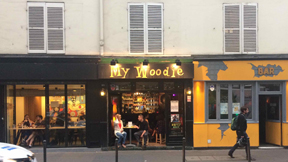 few excellent boulangeries, and then begin the first of many restaurants offering a wide variety of national cuisines. Keep going beyond the Avenue Parmentier and the Avenue de la République to continue this experience, including one of Tom’s favorites, Ave Maria, at 1 rue Jacquard (just off of the rue Oberkampf).
few excellent boulangeries, and then begin the first of many restaurants offering a wide variety of national cuisines. Keep going beyond the Avenue Parmentier and the Avenue de la République to continue this experience, including one of Tom’s favorites, Ave Maria, at 1 rue Jacquard (just off of the rue Oberkampf).
Some of the places look a little rundown, but don’t let that stop you from going in and sampling or even taking on a full meal. Do check out La Mercerie at number 98, which used to be a not-quite dive bar but is now a pretty elegant place.
You'll also find some oddly named places in this neighborhood.
Getting Away From Areas You Always Find Yourself Going Back To
You probably end up in the Latin Quarter a lot, and why wouldn't you? There's all kinds of stuff happening there at all hours. But don't get the idea that that's it: you can find nightlife all over the 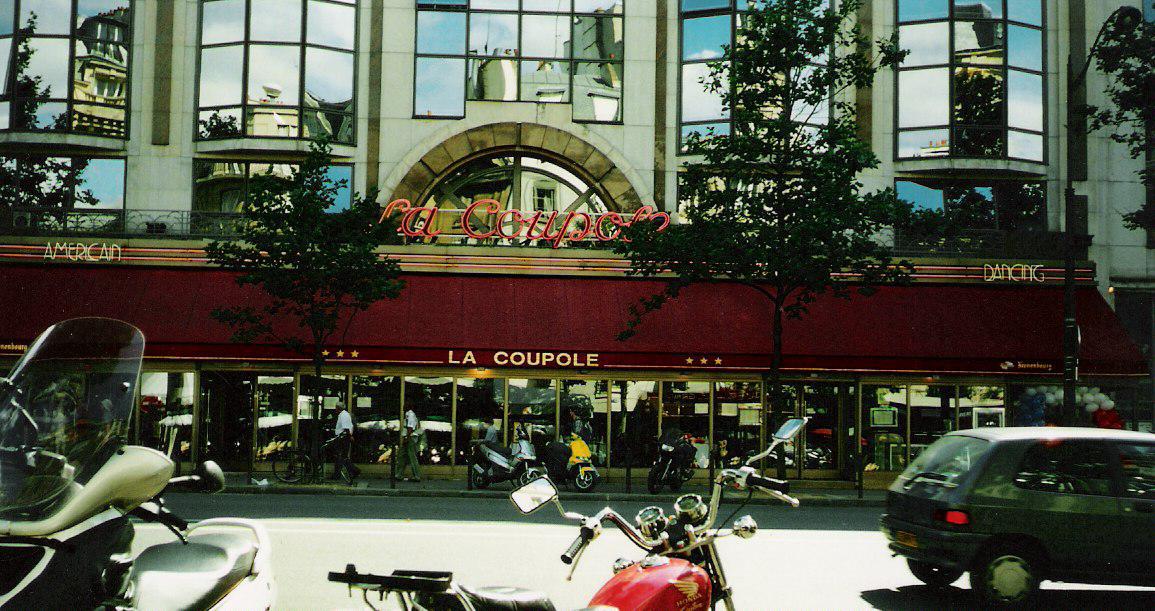 city, in various forms, and sometimes it's an entirely different experience to get away from all those tourists and all those kids. You might try just grabbing the metro or the bus to some area you don't know and exploring. Particularly good areas are:Montmartre (the butte; the Grands boulevards); Montparnasse (Take the metro to Vavin, and try in particular Le Select (99 boulevard Montparnasse); La Rotonde (105 boulevard Montparnasse); Le Dôme(108 boulevard Montparnasse; more of a restaurant); and La Coupole (102 boulevard Montparnasse); Châtelet (especially Au Trappiste [see above]); the carrefour de Bucci and the connecting rue Saint André des Arts (Le Conti [1, rue Buci] and Le Buci [6, rue Buci] are open pretty much all night, and the former has a very friendly British waiter, if you're freaked out about speaking French).
city, in various forms, and sometimes it's an entirely different experience to get away from all those tourists and all those kids. You might try just grabbing the metro or the bus to some area you don't know and exploring. Particularly good areas are:Montmartre (the butte; the Grands boulevards); Montparnasse (Take the metro to Vavin, and try in particular Le Select (99 boulevard Montparnasse); La Rotonde (105 boulevard Montparnasse); Le Dôme(108 boulevard Montparnasse; more of a restaurant); and La Coupole (102 boulevard Montparnasse); Châtelet (especially Au Trappiste [see above]); the carrefour de Bucci and the connecting rue Saint André des Arts (Le Conti [1, rue Buci] and Le Buci [6, rue Buci] are open pretty much all night, and the former has a very friendly British waiter, if you're freaked out about speaking French).
Increasing hot are a couple areas on the Grands Boulevards, which is the long stretch of large 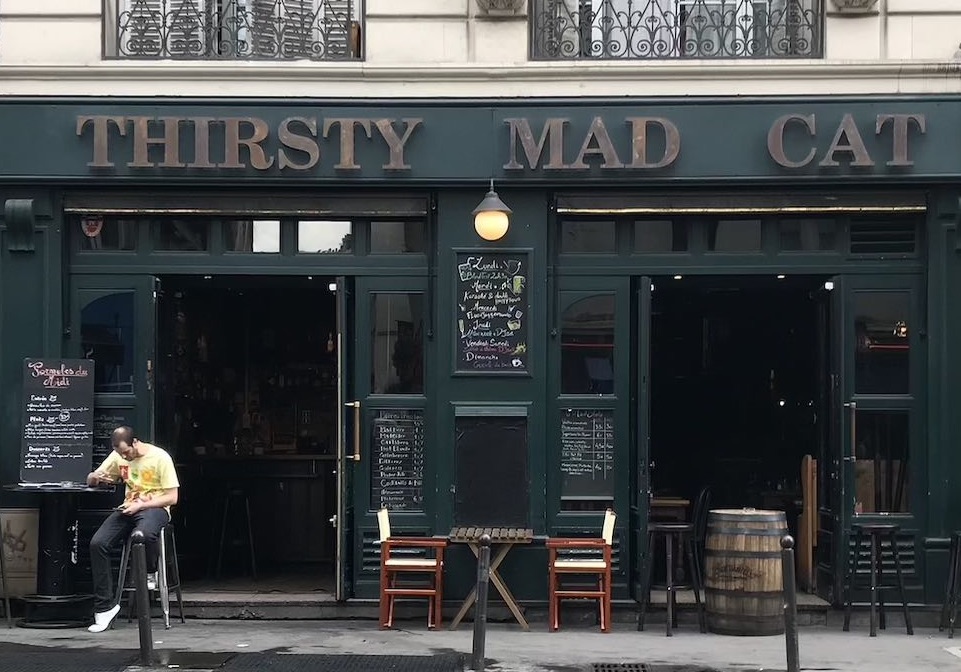 avenues that changes names but looks like one long street in the 9th arrondissement. If you are in your 20's (and no older), start at James Hetfeeld's, at 17, boulevard Poissonnière (metro Grands Boulevards). Then go to the "Australian" Café Oz at 18, boulevard Montmartre, just a short hop down the road. You'll find a lot in this area if you begin at Hetfeeld's and then keep heading west on the Grands Boulevards. For example, you'll want to pop in at Thirsty Mad Cat at 120 rue Montmartre (not the rue Montmartre), just a few streets away. This is a sort of sports bar, but mainly a party bar, and oddly enough they take reservations (for what I don't know).
avenues that changes names but looks like one long street in the 9th arrondissement. If you are in your 20's (and no older), start at James Hetfeeld's, at 17, boulevard Poissonnière (metro Grands Boulevards). Then go to the "Australian" Café Oz at 18, boulevard Montmartre, just a short hop down the road. You'll find a lot in this area if you begin at Hetfeeld's and then keep heading west on the Grands Boulevards. For example, you'll want to pop in at Thirsty Mad Cat at 120 rue Montmartre (not the rue Montmartre), just a few streets away. This is a sort of sports bar, but mainly a party bar, and oddly enough they take reservations (for what I don't know).
You also don't want to miss the rue Montorgueil scene. The rue Montorgueil, which begins just north of Les Halles, was gentrified a number of years ago, and it's 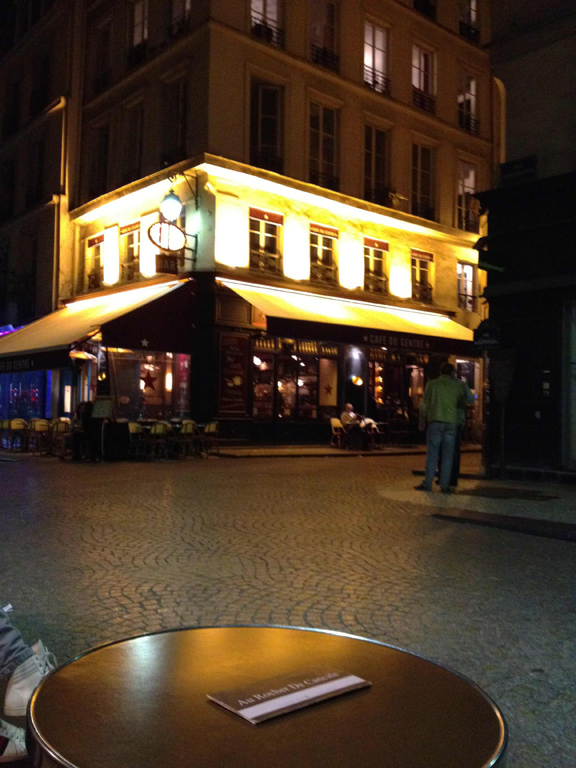 mostly a pedestrian street now, although cars do come (slowly) through sometimes. In the five or six blocks of its length you'll find a lot of very trendy places to eat and drink, and an interesting mix of very trendy people and very ordinary ones. This is a good place to go if you want to check out a scene but don't feel comfortable going to a club. It's happening pretty much all day long, but the scene changes, as you might imagine. At lunch time it's mobbed, mostly with locals and people who work in the area. At the after-work hours its mostly 20-somethings meeting friends for drinks, with a lot of others mixed in (don't feel left out if this isn't your demographic—this is a pretty open area and you'll feel pretty much at home here). Late night it's a good place to sit and nurse a drink (pictured here is the Café du Centre, taken from our table at the Rocher de Cancale). You should also check out the rue Montmartre, just a couple streets over.
mostly a pedestrian street now, although cars do come (slowly) through sometimes. In the five or six blocks of its length you'll find a lot of very trendy places to eat and drink, and an interesting mix of very trendy people and very ordinary ones. This is a good place to go if you want to check out a scene but don't feel comfortable going to a club. It's happening pretty much all day long, but the scene changes, as you might imagine. At lunch time it's mobbed, mostly with locals and people who work in the area. At the after-work hours its mostly 20-somethings meeting friends for drinks, with a lot of others mixed in (don't feel left out if this isn't your demographic—this is a pretty open area and you'll feel pretty much at home here). Late night it's a good place to sit and nurse a drink (pictured here is the Café du Centre, taken from our table at the Rocher de Cancale). You should also check out the rue Montmartre, just a couple streets over.
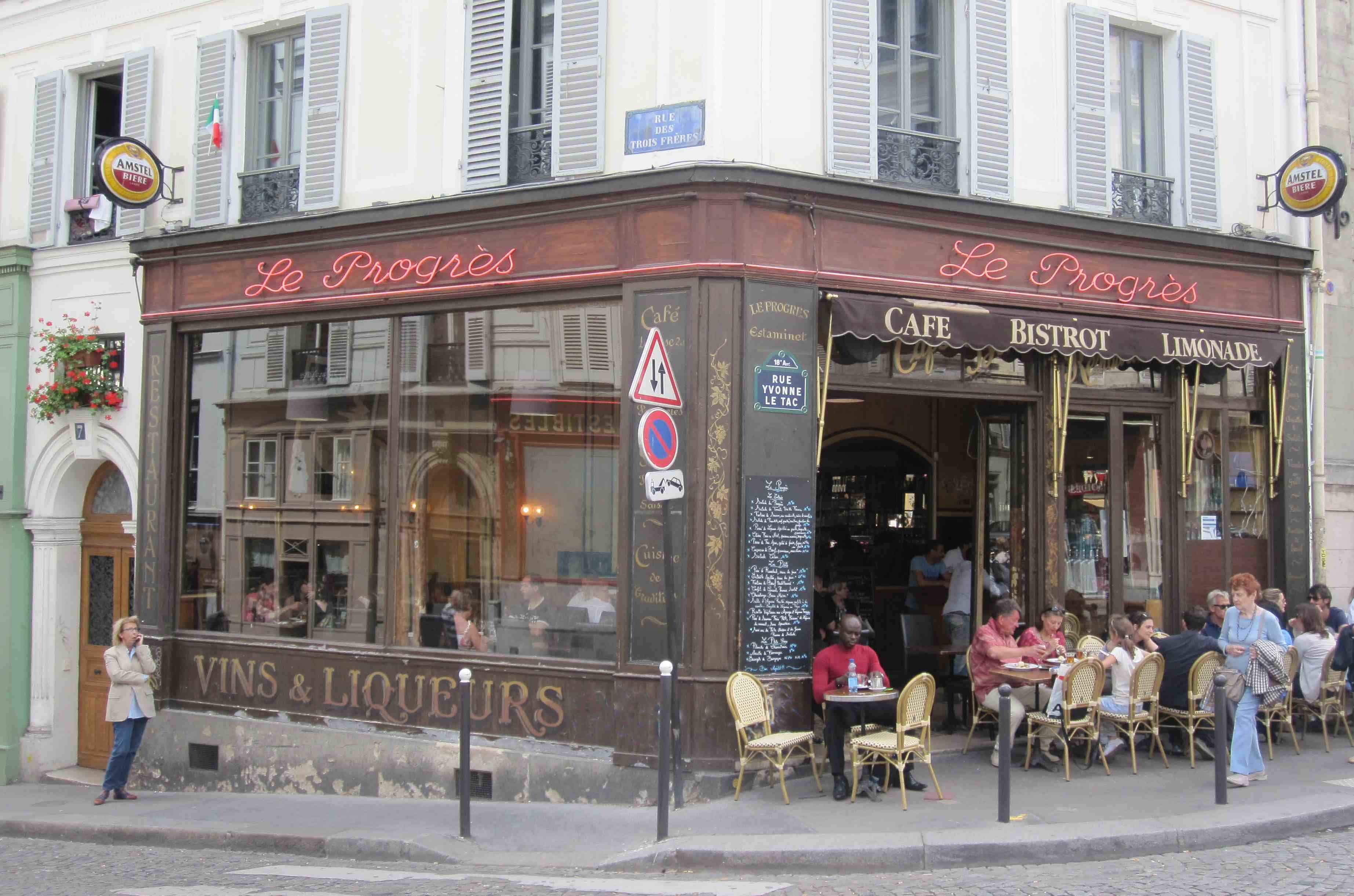 If you're up in the Montmartre area and want to grab a beer at an interesting, sort of art-deco bar, head over to 1, rue Yvonne le Tac to Le Progrès. It's just around the corner from the bottom of the funiculaire, that strange streetcar that takes you up or down the steepest part of the Montmartre hill, and it's got an interesting crowd, a good selection of beers, very reasonable prices, and a cool atmosphere. The closest metros are Abesses and Anvers.
If you're up in the Montmartre area and want to grab a beer at an interesting, sort of art-deco bar, head over to 1, rue Yvonne le Tac to Le Progrès. It's just around the corner from the bottom of the funiculaire, that strange streetcar that takes you up or down the steepest part of the Montmartre hill, and it's got an interesting crowd, a good selection of beers, very reasonable prices, and a cool atmosphere. The closest metros are Abesses and Anvers.
Places that are open all night: not always as easy to find as you might like. Many places close between 1:00 and 3:00. After that you're limited to Polly Magoo (see above), and a few of the others mentioned. There's a café behind the fontaine St. Michel at the bottom of the boulevard St. Michel (on the rue Hautefeuille) that is usually open all night or at least very late, and one across the street as well. The one on the Place closes around 1:00. If you find yourself in the 9th or 10th late at night, there's a café right near the metro Bonne Nouvelle (either on the boulevard Poissonnière or Bonne Nouvelle, but they're effectively the same street) that is completely uninteresting but open all night. They have a large German shepherd here that might chase you. There 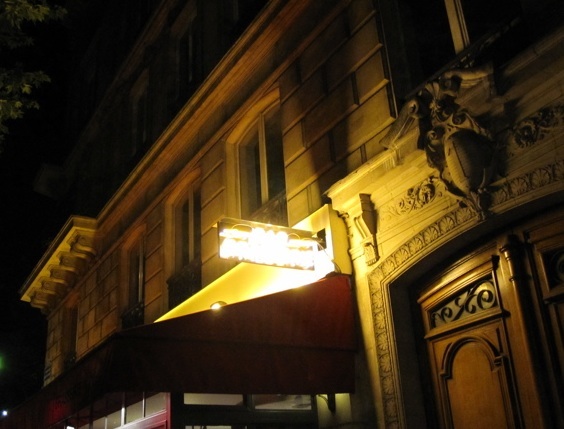 are also several all-night cafés near the Tour St. Jacques (right by the Place du Châtelet) which for some mysterious reason tend to be open sometimes and not others. You will likely see a broad mix of very colorful people in this neighborhood. Try especially the Sarah Bernhardt (2, place du Châtelet—but their website appears to be stuck in time). These are also good because if you're going to take the night bus home, you can have a drink here before you get the bus (and learn how to take the night bus here). There also used to be this really strange place on the rue Dauphine (metro Odéon) that didn't know if it was a restaurant, bar, or night club. It was called Dom Carlos, and you had to really look for it because it was buried in the wall and it was truly tiny. It was quite unusual. There would always be a lot of people speaking Spanish here. It was quite expensive, but sometimes people just ordered food for you and would pay for you and didn't expect any sexual favors or anything in return. This seemed to work for both sexes and there was nothing weird or sinister about it—the people just genuinely seemed to enjoy doing it. There were usually people dancing on the tables. Alas, it's gone.
are also several all-night cafés near the Tour St. Jacques (right by the Place du Châtelet) which for some mysterious reason tend to be open sometimes and not others. You will likely see a broad mix of very colorful people in this neighborhood. Try especially the Sarah Bernhardt (2, place du Châtelet—but their website appears to be stuck in time). These are also good because if you're going to take the night bus home, you can have a drink here before you get the bus (and learn how to take the night bus here). There also used to be this really strange place on the rue Dauphine (metro Odéon) that didn't know if it was a restaurant, bar, or night club. It was called Dom Carlos, and you had to really look for it because it was buried in the wall and it was truly tiny. It was quite unusual. There would always be a lot of people speaking Spanish here. It was quite expensive, but sometimes people just ordered food for you and would pay for you and didn't expect any sexual favors or anything in return. This seemed to work for both sexes and there was nothing weird or sinister about it—the people just genuinely seemed to enjoy doing it. There were usually people dancing on the tables. Alas, it's gone.
The cafés in the Pigalle area tend to be open very late, and sometimes all night. They'll be somewhat more expensive than most, but not that much more. You'll very likely be treated to some sordid sights, what with all the different kinds of sex workers and all, and you might even be verbally harassed a bit, but nothing to worry about. Just tell the person harassing you to get lost (unless it's the waiter). The café at the corner of the boulevard de Rochechouart and the rue des Martyrs is a haunt for the neighborhood professionals, mostly when they're calling it a night. Pigalle is not dangerous, certainly not compared to the rue St. Denis (and especially in its former configurations) which isn't really that bad, either. Its bark is much worse than its bite, but you really ought to be 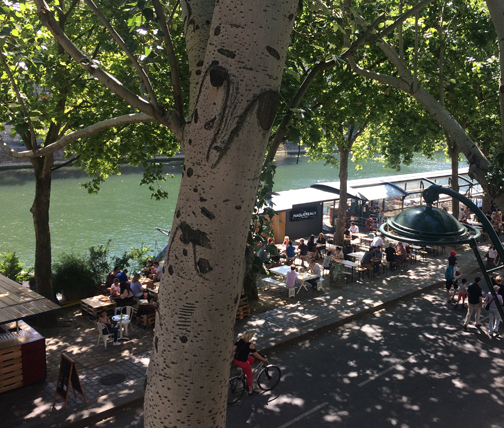 vigilant when walking around here, just to be sure. It's become much more plastic and neon in the past several years. It'll probably remind you of a kind of sordid Las Vegas.
vigilant when walking around here, just to be sure. It's become much more plastic and neon in the past several years. It'll probably remind you of a kind of sordid Las Vegas.
Take me to the river…
If it's a sunny Sunday afternoon, and you're not sure what to do, head over to the river. Or, if the night's young, and you're not sure where you're going yet, go to the Seine. Or if you've just painted the town red, it's 2:00 in the morning, and you're not sure what to do next, do what everyone else does: go to the river. Take your guitar or your rollerblades, your partner or your picnic basket. Pack a snack or steer toward beer. You do the river in your own way.
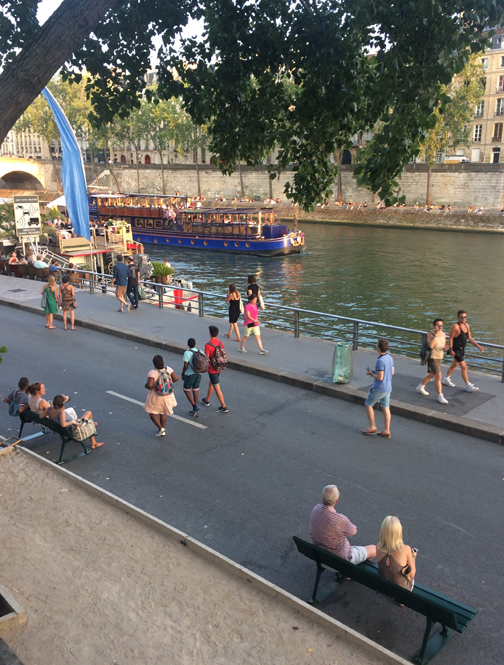 The city closed down the expressway that used to run along the river on the right bank and they turned it into a pedestrian paradise. The goal is to make Paris greener and more pedestrian friendly, and while some people complained about this, the sheer volume of people who show up when the weather is nice pretty much tell the story of who won this battle. The stretch of the Seine from roughly the Ile Saint-Louis to the Louvre and beyond is typically packed with people when the weather is nice (and sometimes even when it's not). On weekend afternoons (in particular), people will be lazing about, reading, chatting, strolling; sometimes there will be specific activities arranged (and I don't know by whom) such as waltzing or drumming.
The city closed down the expressway that used to run along the river on the right bank and they turned it into a pedestrian paradise. The goal is to make Paris greener and more pedestrian friendly, and while some people complained about this, the sheer volume of people who show up when the weather is nice pretty much tell the story of who won this battle. The stretch of the Seine from roughly the Ile Saint-Louis to the Louvre and beyond is typically packed with people when the weather is nice (and sometimes even when it's not). On weekend afternoons (in particular), people will be lazing about, reading, chatting, strolling; sometimes there will be specific activities arranged (and I don't know by whom) such as waltzing or drumming.
On nice evenings, many people pack picnic 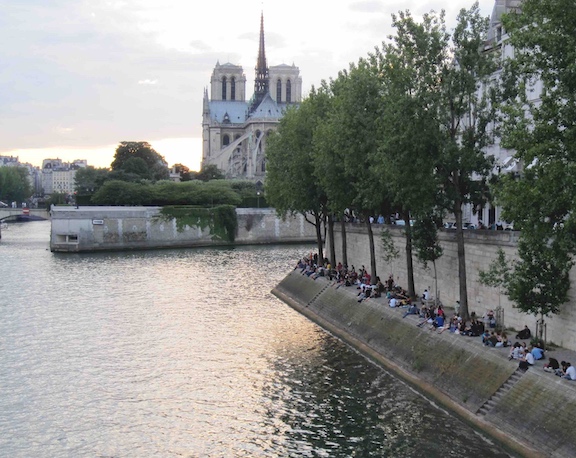 dinners or snacks and enjoy leisurely meals, especially as the sun is setting. Others bring things to drink and sip their beverages watching all the pedestrians pass by. You can also buy food and drink at different pop-up locations along the river. The Pont des Arts, a wooden-decked pedestrian bridge, is a particular favorite with many, many people, a great deal of whom bring somewhat elaborate meals spread out on blankets. People used to lock padlocks onto this bridge, as some type of testament to the "locked", undying love of their relationship (and they would put their initials on them, the way you did in elementary school: T. R + L. B). The city feared that the weight of the locks—there really were a tremendous amount of them—would stress the bridge and they began cutting them off.
dinners or snacks and enjoy leisurely meals, especially as the sun is setting. Others bring things to drink and sip their beverages watching all the pedestrians pass by. You can also buy food and drink at different pop-up locations along the river. The Pont des Arts, a wooden-decked pedestrian bridge, is a particular favorite with many, many people, a great deal of whom bring somewhat elaborate meals spread out on blankets. People used to lock padlocks onto this bridge, as some type of testament to the "locked", undying love of their relationship (and they would put their initials on them, the way you did in elementary school: T. R + L. B). The city feared that the weight of the locks—there really were a tremendous amount of them—would stress the bridge and they began cutting them off.
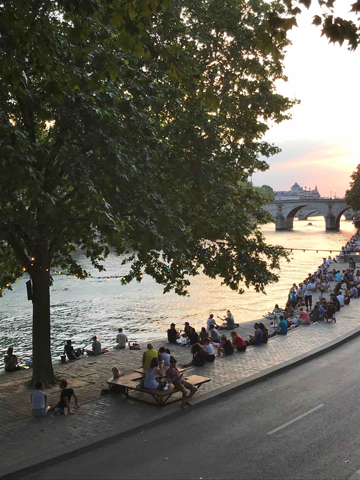 Late at night the youth take over. There's typically music, sometimes electrically powered, but often of the stringed type, and there will be singing—not always very good, depending on how much drink is fueling the levity—and other forms of merriment. There is nearly always some form of drumming. While things will thin out after about 1:00 AM, you can count on the hardcore folks holding out until sunrise (and if you haven't done it, it's really worth seeing the sunrise while you're hanging out along the banks of the Seine).
Late at night the youth take over. There's typically music, sometimes electrically powered, but often of the stringed type, and there will be singing—not always very good, depending on how much drink is fueling the levity—and other forms of merriment. There is nearly always some form of drumming. While things will thin out after about 1:00 AM, you can count on the hardcore folks holding out until sunrise (and if you haven't done it, it's really worth seeing the sunrise while you're hanging out along the banks of the Seine).
The great thing about going to the river is that you can do it alone, or in large groups of friends. Depending on the area you go to—and the closer to the center of the city, the more crowded it tends to be—you'll find small groups or entire throngs. Check out in particular the riverbanks on the Ile Saint-Louis, the Pont des Arts, and by the Hôtel de Ville. You'll like this.
…Or the Canal
The Canal Saint-Martin has for some time been a trendy hangout for mostly young people who tend to be either stylishly hip, street wise, or just plain ordinary folks. You'll also see older people who live in the neighborhood that has been invaded by more and more people who just like hanging out at the canal and frequenting the increasingly trendy bars and restaurants that border it.
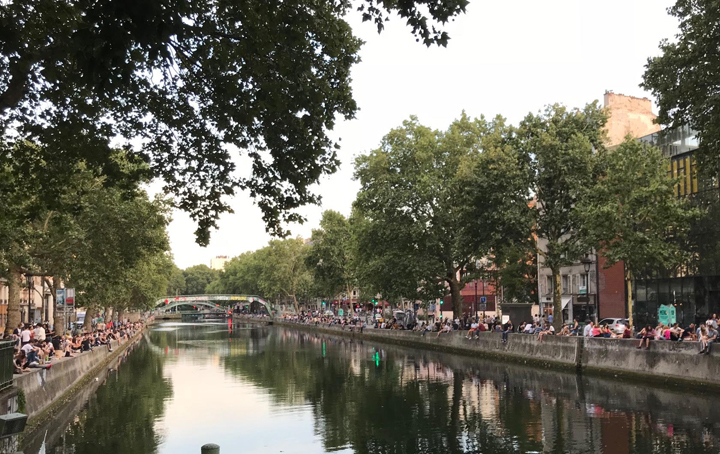 People come here at all times of the day, but you'll find that the evening hours just before dinnertime and just after might be the most popular. This is great place to meet and hang out before you go out for the night, or, indeed, a great place to meet up in order to determine your evening's plans.
People come here at all times of the day, but you'll find that the evening hours just before dinnertime and just after might be the most popular. This is great place to meet and hang out before you go out for the night, or, indeed, a great place to meet up in order to determine your evening's plans.
The canal was built in the first part of the nineteenth century as a means of transport through the city and also to provide fresh water to the city (water comes from the river Ourcq). There are boats the travel along the canal—and there are locks along the route—as well as a series of arching bridges that cross over it, giving you ample opportunity to take interesting photos (see?).
Bars and restaurants line the canal and the side streets around it. Chez Prune (36 rue Beaurepaire) is a true classic, and it will give you some of the best people watching in the city. It's also crazy popular, so expect either not to get one of its outdoor tables or to have to wait a while to sit down. Another favorite in the neighborhood is Marcel (90 Quai de Jemmapes). Marcel is a sort of mix of Indian and Western food, and it's interesting if not always completely successful. Nevertheless it's worth it for its charm and location.
Readers Chime InA reader recommends the Auld Alliance Pub at 80, rue François Miron in the 4th arrondissement (01 48 04 30 40, metro Saint-Paul). "It's not a hot spot, but kind of a quiet refuge if you are tired of speaking French or if you like football. Auld Alliance is generally a Rangers pub, and gets a great crowd for Scotland games. Football is a great way to get into European 'culture.'" Tom seconds this recommendation. Tim gives a lot of reasons why everyone should head over to Le Rostand, a café on the corner of the rue Soufflot and the boulevard St Michel (6, place Edmond Rostand; 01 43 54 61 58, metro Cluny-La Sorbonne, Odéon, or RER Luxembourg). Tim writes: "Gerard Dépardieu served Gina Rowlands a glass of Graves here in "Paris, je t'aime." Le Rostand is a good café in Paris for a rendez-vous, centrally located but around the corner from the mayhem of the Boulevard St. Michel. perfect for a coffee date. It faces an entrance to the Luxembourg garden across the street. You can watch the parade of Parisians taking a moment out of their day for a stroll. Stylish, but not chi-chi. A classic but unpretentious café in a great neighborhood." OK. I've told you my favorite places to hang out; now it's your turn to add something to the guide. Do you have a favorite place that you always go to? Whether it's a sophisticated café populated by the beautiful set, or a hole-in-the-wall dive that most people would be afraid to set foot in, Tom's Guide wants to know about it. Click here to suggest a hangout of your own. |